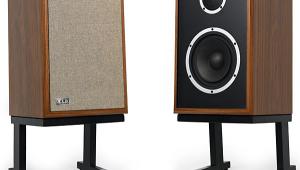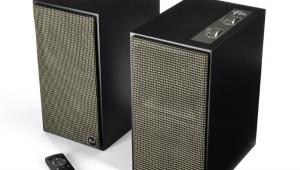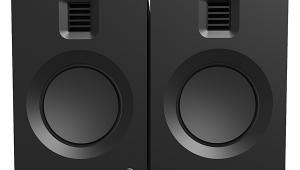I have owned my Aon 3's for almost a year now, and they continue to impress. Totally agree with the review. Can't wait to see the review on the new triton 7 towers. Keep up the good work GoldenEar! Thanks to Mark for an honest review as well....
GoldenEar Aon 2 Speaker System

A review is more interesting when it tells a story. How should the story of the GoldenEar Aon 2 begin? There’s the technology angle: The Aon 2 is among the few speakers on the market with an unusual pleated tweeter design that uses a squeezing motion (as opposed to a piston motion) to generate the changes in air pressure that we hear as sound waves. Because the benefits—wide horizontal dispersion and vivid imaging—are easy to describe, that would be a good way to begin. And then there’s the human interest angle: GoldenEar is the third brand to be cofounded by Baltimore-based loudspeaker impresario Sandy Gross, whose genuine love for audio is balanced by his love for gourmet food, Expressionist canvases, and ancient statuary. The only thing wrong with these angles is that reviewers hither and yon have used them so often in the past. That leaves the musical angle. Here I believe I have a variant that might qualify as an exclusive.
A new turntable purchase has fostered an obsession with filling gaps in my vinyl library. One of the first acquisitions to arrive in the mail was Abbey Road, the final album recorded by the Beatles. Heard through my reference system, the LP proved to be just what I’d prayed for. Despite some crackle, the music communicated, and smoothly enough to be played extra-loud. The vinyl met my standards for demo material and then some, so when the GoldenEars were set up just days later, I couldn’t resist another listen. The result was an eye opener. Sweetheart, get me rewrite!
It’s Not Just the Tweeter
The system under review
mated five Aon 2 monitors
with the new ForceField 5 subwoofer. The GoldenEar site recommends another configuration with a pair of either the
Aon 2 or Aon 3 along with models from the Super-Cinema Series including the SuperSat3C center, SuperSat 3 surrounds,
and ForceField 3 sub. The SuperSat 50C center also uses
the same tweeter and is said to mate well with the Aons. Either
of these might work better if
the Aon 2’s 12-inch height
doesn’t fit the center spot in
your furniture or speaker setup. See our separate review of the SuperCinema models (Home Theater, November 2011 issue
or at HomeTheater.com).

Even at first glance, you can see the Aon 2 is different. Wrapped in fabric, it disdains the right angles that dominate speaker design, with its front face combining obtuse (greater than 90-degree) angles at top with acute (less than 90-degree) angles at bottom. Why does it take this truncated- pyramid form? Gross explains: “The pyramidal shape allows the area around the tweeter to be narrower (for better imaging) and also spreads out the diffraction effects of the cabinet over a broader range.” (Control of diffraction emerged as a recurring theme.) Compared with a conventional parallel-walls enclosure, it also mitigates internal standing waves, which can muddy sound. The ForceField 5 subwoofer adopts a similar shape for similar reasons.
GoldenEar refers to its tweeter as a High-Velocity Folded Ribbon tweeter; it measures a visible 1.5 by 1.75 inches, incorporates a diaphragm measuring 1.5 by 5.5 inches when unfolded, and is made for GoldenEar out of non-conductive pleated Kapton polyamide film with a bonded conductive trace to carry the audio signal. Technically speaking, a true ribbon transducer has a diaphragm that is itself conductive and carries the audio signal, while this tweeter would more accurately be described as a variation within the planar magnetic driver family. Either way, it’s hard to argue with the results. It has a unique faceplate forming an aperture that offers acoustic impedance matching and control of directivity and diffraction. The tweeter is mounted 0.75 inches off center in the Aon 2, uniformly to the right (no mirror-imaged pairs). Gross says this is another means of reducing diffraction-related anomalies—“actually little ripples in the frequency response”—that are caused by the discontinuity of the baffle surface at the edges of the cabinet.
Lest you consider the Aon 2 a technological one-trick pony, the tweeter is not its only noteworthy feature. In fact, it’s the integration of the tweeter into other design features that enables this speaker to attain the balanced performance I witnessed in the ensuing demos. The Aon 2 also has a 6-inch mineral-filled polypropylene bass driver with a Multi-Vaned Phase Plug at the center of the cone. The plug’s purpose is to control the riot of energy near the apex of the cone; its shape minimizes diffraction from the plug itself.

On each side is a 6.5-inch flat passive radiator, which GoldenEar correctly calls a Low Frequency Radiator. Made of Medite—an especially dense wood and resin-based material similar to fiberboard—it gives the speaker an enviable degree of bass extension for its size with no messy port chuffing. It’s remarkable to find this kind of design and construction in a speaker selling for just $400/each. (In the larger Aon 3, $500/each, the bass driver is 7 inches, and the Low Frequency Radiators are 8 inches.)
The ForceField 5 ($1,000), with its 12-inch woofer, is the latest in a series that already includes the 10-inch ForceField 4 ($700) and the 8-inch ForceField 3 ($500). Much of this 46-pound brute’s weight comes from its thick fiberboard enclosure: 1.5 inches at the front baffle, 1.25 inches at the rear baffle, and 0.75 inches at the sides. On the front is the active driver, its cone made of resin- and mineral-impregnated felted paper. On the bottom is a 13 x 14–inch Quadratic Planar Infrasonic Radiator (or rectangular flat passive radiator). In the sub, as in the speakers, it enhances bass extension while avoiding the unsubtle whistles and sputters of many ported sub designs. The internal amp, designed in house, is rated at 1,500 watts, actually splitting the difference between RMS (1,000) and peak (2,000) power claims.
Associated equipment included a Pioneer Elite VSX-53 A/V receiver, Oppo BDP-83SE universal disc player, Micro Seiki BL-51 turntable, Shure M97xE cartridge, and Onix OA 21s integrated amp serving as phono preamp.
Grace and Power
Few speakers in my experience have gotten through both movie and music demos with such unfaltering grace and power as the Aon 2. It made available all the most desirable attributes of all the content I threw at it, missing nothing. While it was revealing enough to uncover flaws in content, it didn’t emphasize them, and my comfort level remained high when movie soundtracks waxed bombastic. The soundfield was large and—as one would expect with five matched speakers—continuous. Objects within it were clearly delineated but not excessively outlined or etched. Highs were extended and airy, midrange full of variety and detail, and—most surprising in a foot-tall speaker—bass was punchy. Overall, the speaker offered a degree of transparency that was highly unusual at this price point.
- Log in or register to post comments


























































